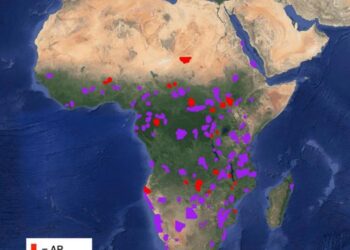Researchers from The University of Texas at Dallas and Seoul National University have developed an imager chip inspired by Superman’s X-ray vision that could be used in mobile devices to make it possible to detect objects inside packages or behind walls.
Chip-enabled cellphones might be used to find studs, wooden beams or wiring behind walls, cracks in pipes, or outlines of contents in envelopes and packages. The technology also could have medical applications.
The researchers first demonstrated the imaging technology in a 2022 study. Their latest paper, published in the March print edition of IEEE Transactions on Terahertz Science and Technology, shows how researchers solved one of their biggest challenges: making the technology small enough for handheld mobile devices while improving image quality.
“This technology is like Superman’s X-ray vision. Of course, we use signals at 200 gigahertz to 400 gigahertz instead of X-rays, which can be harmful,” said Dr. Kenneth K. O, director of the Texas Analog Center of Excellence (TxACE) and the Texas Instruments Distinguished University Chair in the Erik Jonsson School of Engineering and Computer Science.
The research was supported by the Texas Instruments (TI) Foundational Technology Research Program on Millimeter Wave and High Frequency Microsystems and the Samsung Global Research Outreach Program.
“It took 15 years of research that improved pixel performance by 100 million times, combined with digital signal processing techniques, to make this imaging demonstration possible. This disruptive technology shows the potential capability of true THz imaging,” said Dr. Brian Ginsburg, director of RF/mmW and high-speed research at TI’s Kilby Labs.
With privacy issues in mind, the researchers designed the technology for use only at close range, about 1 inch from an object. For example, if a thief tried to scan the contents of someone’s bag, the thief would need to be so close that the person would be aware of what they were doing, O said. The next iteration of the imager chip should be able to capture images up to 5 inches away and make it easier to see smaller objects.
The imager emits 300-GHz signals in the millimeter-wave band of electromagnetic frequencies between microwave and infrared, which the human eye cannot see and is considered safe for humans. A similar technology, using microwaves, is used in large, stationary passenger screeners in airports.
“We designed the chip without lenses or optics so that it could fit into a mobile device. The pixels, which create images by detecting signals reflected from a target object, have the shape of a 0.5-mm square, about the size of a grain of sand,” said Dr. Wooyeol Choi, assistant professor at Seoul National University and the corresponding author of the latest paper.
The advances to miniaturize the imager chip for mobile devices are the result of nearly two decades of research by O and his team of students, researchers and collaborators through the TxACE at UT Dallas. TxACE is supported by the Semiconductor Research Corp., TI, the UT System and UT Dallas.
A study author and electrical engineering graduate student Walter Sosa Portillo BS’21 came to work in O’s lab as an undergraduate after learning about this imaging research.
“The first day I came to orientation, they talked about Dr. O’s research, and I thought it was really interesting and pretty cool to be able to see through things,” said Portillo, who is researching medical applications for the imager.
Additional co-authors of the study include first author Pranith Reddy Byreddy MS’16, PhD’22, now at Qualcomm Technologies Inc.; Yukun Zhu PhD’22, now at HiSilicon in China; electrical engineering doctoral student Suprovo Ghosh MS’19; Harshpreet Singh Bakshi MS’18, PhD’22, now at TI; electrical engineering doctoral student Jayson P. Van Marter BS’20; and Dr. Murat Torlak, professor of electrical and computer engineering.
Discover more from Science
Subscribe to get the latest posts sent to your email.



